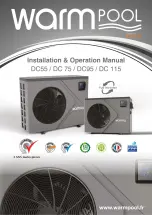
4
Fig. 3-3
Fig. 3-4
Fig. 3-2
3. Installation location
3.1. Refrigerant pipe
Refer to 5.2. Pipe length and height difference.
3.2. Choosing the outdoor unit installation location
• Avoid locations exposed to direct sunlight or other sources of heat.
• Select a location from which noise emitted by the unit will not inconvenience
neighbors.
• Select a location permitting easy wiring and pipe access to the power source and
indoor unit.
• Avoid locations where combustible gases may leak, be produced, flow, or accumu-
late.
• Note that water may drain from the unit during operation.
• Select a level location that can bear the weight and vibration of the unit.
• Avoid locations where the unit can be covered by snow. In areas where heavy snow
fall is anticipated, special precautions such as raising the installation location or
installing a hood on the air intake must be taken to prevent the snow from blocking
the air intake or blowing directly against it. This can reduce the airflow and a mal-
function may result.
• Avoid locations exposed to oil, steam, or sulfuric gas.
• Use the transportation handles of the outdoor unit to transport the unit. If the unit is
carried from the bottom, hands or fingers may be pinched.
3.3. Outline dimensions (Outdoor unit) (Fig. 3-1)
Constraints on indoor unit installation
You should note that indoor units that can be connected to this outdoor unit are the
following models.
• Indoor units with model numbers 22, 25, 35, 50, 60, 71, 80 can be connected. Refer
to the table below for possible 2-8 room, indoor unit combinations.
Verification
The rated capacity should be determined by observing the table below. The unit’s
quantities are limited in 2 to 8 units. For the next step, make sure that the total rated
capacity selected will stay in a range of 4.4 - 18.5 kW.
Example:
MSZ-60
=
6.0
+
SEZ-35
=
3.5
+
SLZ-35
=
3.5
Total rated capacity
+
SEZ-25
=
2.5
18.0
≤
18.5 kW
+
SLZ-25
=
2.5
Indoor unit type
22
25
35
50
60
71
80
Rated capacity (Cooling) (kW)
2.2
2.5
3.5
5.0
6.0
7.1
8.0
Combinations in which the total capacity of indoor units exceeds the capacity of the
outdoor unit (=14.0 kW) will reduce the cooling capacity of each indoor unit below
their rated cooling capacity. Thus, combine indoor units with an outdoor unit within
the outdoor unit’s capacity (=14.0 kW), if possible.
3.4. Ventilation and service space
3.4.1. Windy location installation
When installing the outdoor unit on a rooftop or other location unprotected from the
wind, situate the air outlet of the unit so that it is not directly exposed to strong winds.
Strong wind entering the air outlet may impede the normal airflow and a malfunction
may result.
The following shows three examples of precautions against strong winds.
1
Face the air outlet towards the nearest available wall about 50 cm away from the
wall. (Fig. 3-2)
2
Install an optional air guide if the unit is installed in a location where strong winds
from a typhoon, etc. may directly enter the air outlet. (Fig. 3-3)
A
Air guide
3
Position the unit so that the air outlet blows perpendicularly to the seasonal wind
direction, if possible. (Fig. 3-4)
B
Wind direction
Fig. 3-1
(mm)
B
950
330+30
1350
175
600
370
A
Summary of Contents for MXZ-8A140VA
Page 1: ......


































